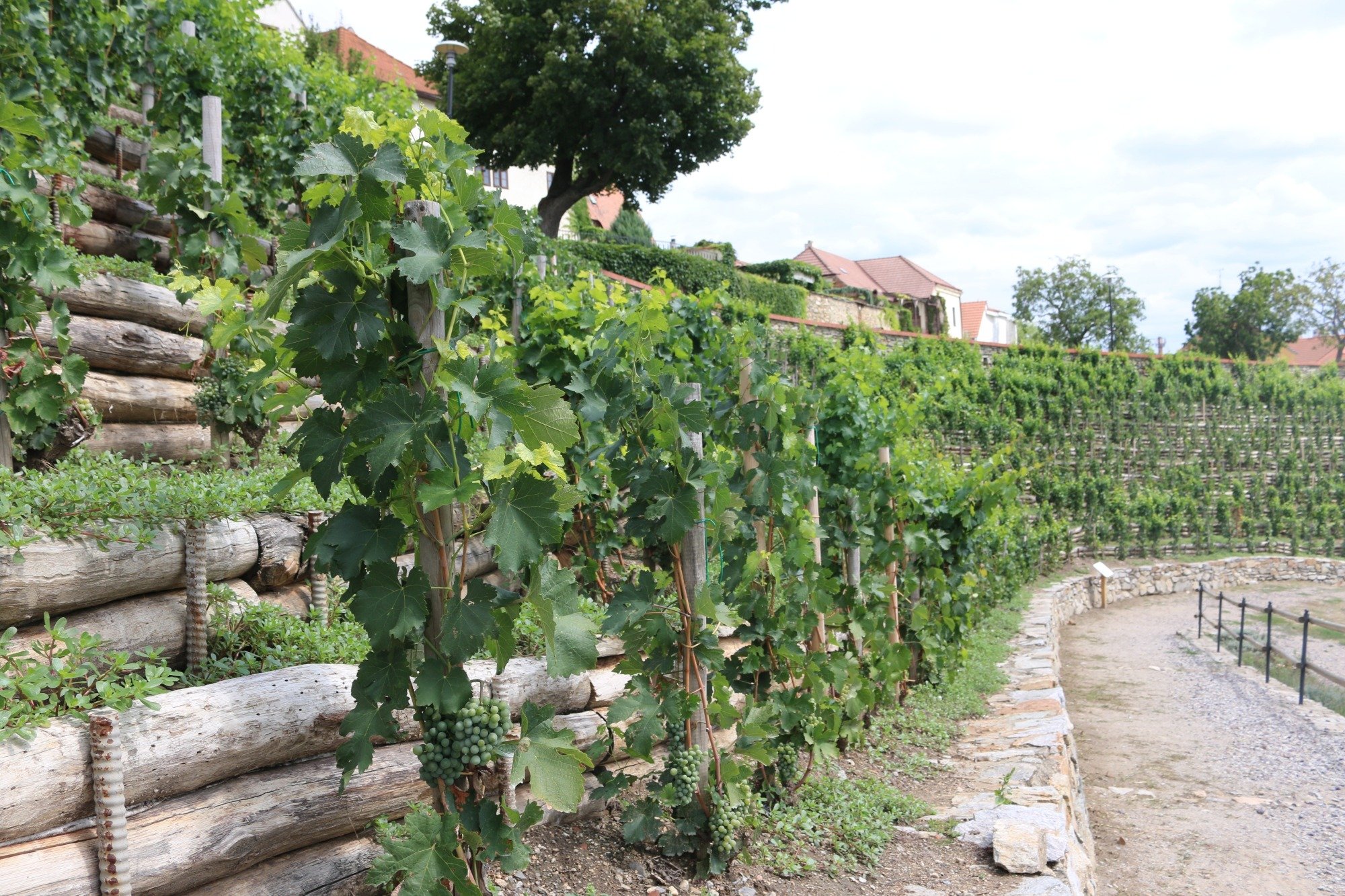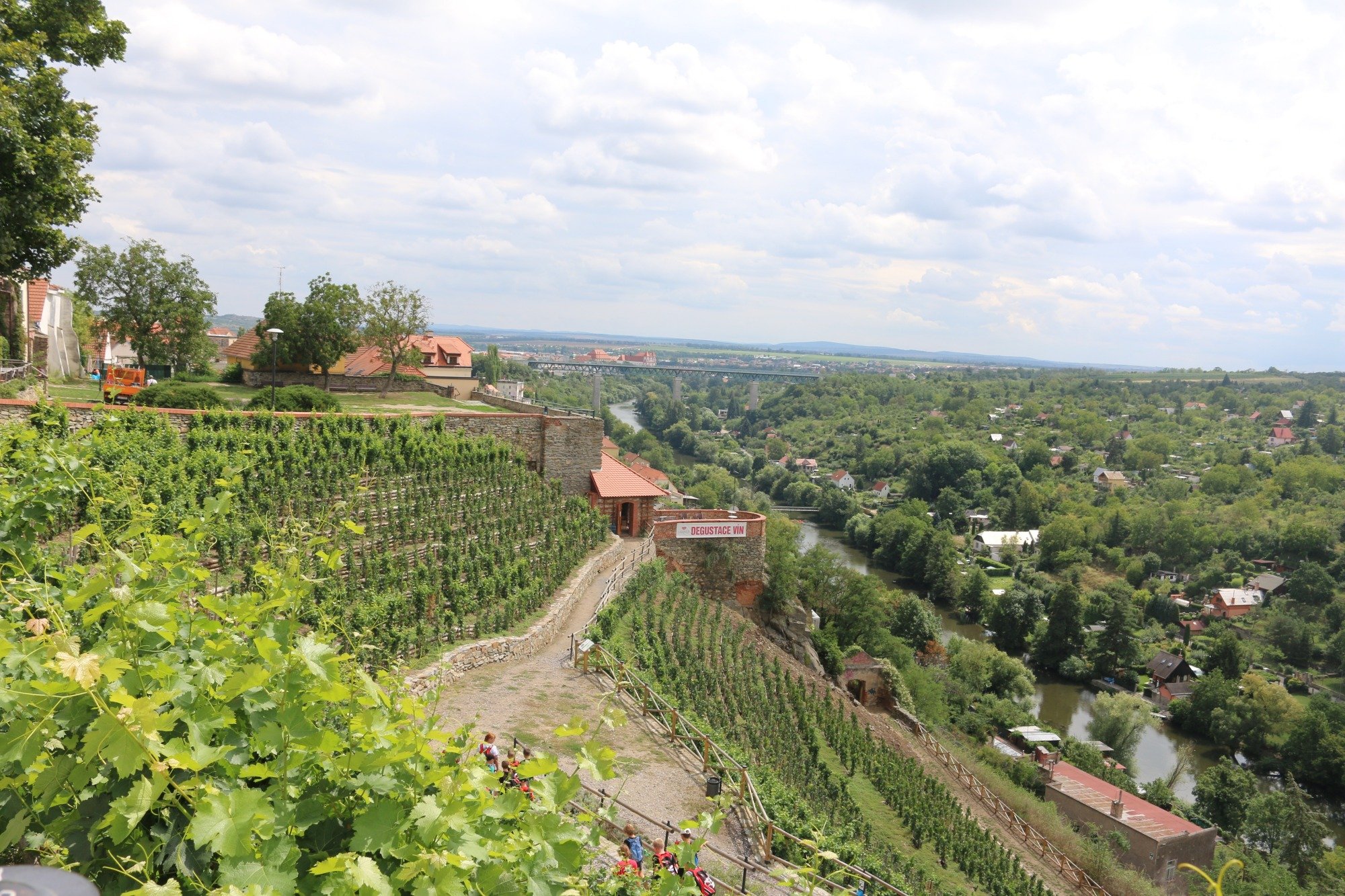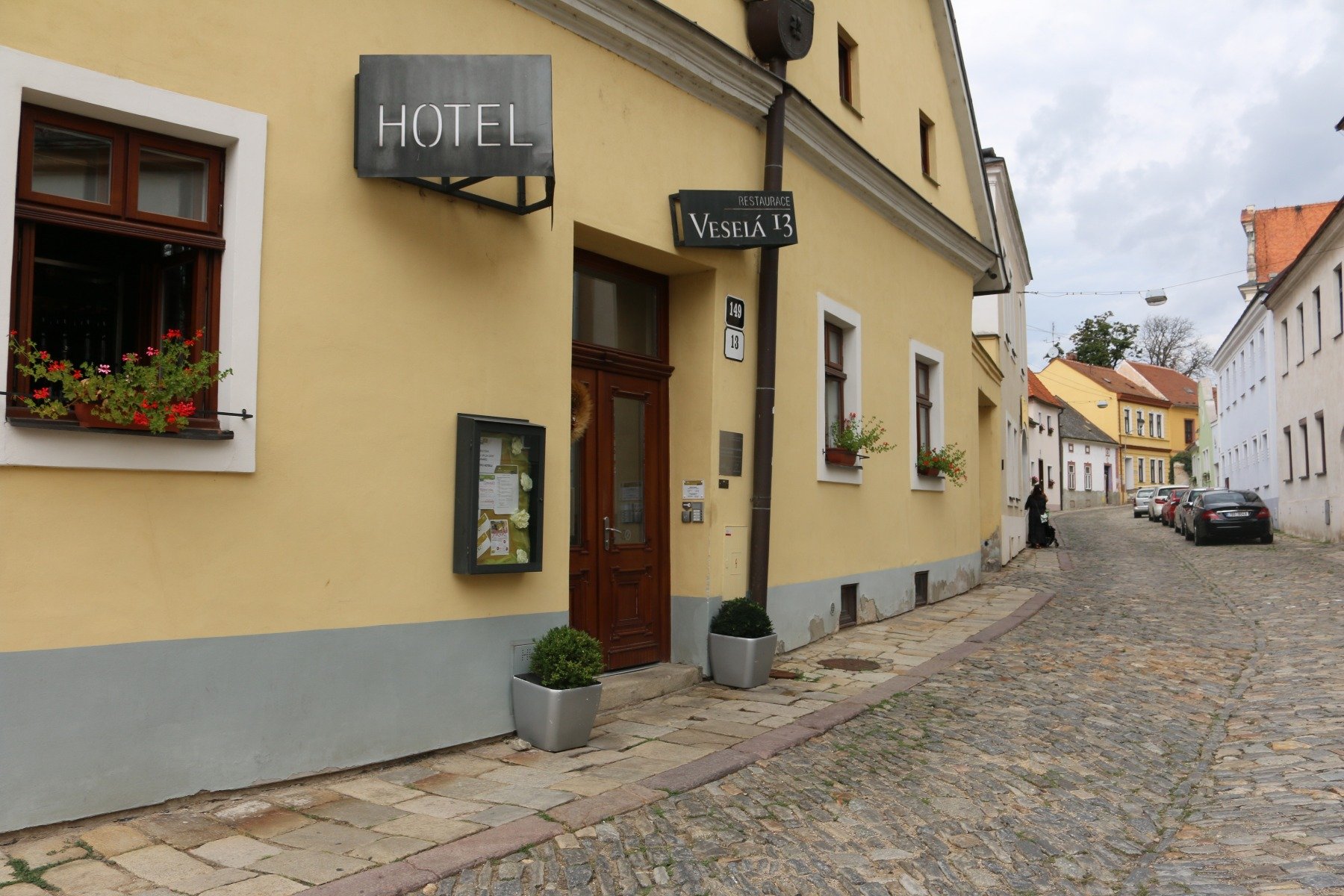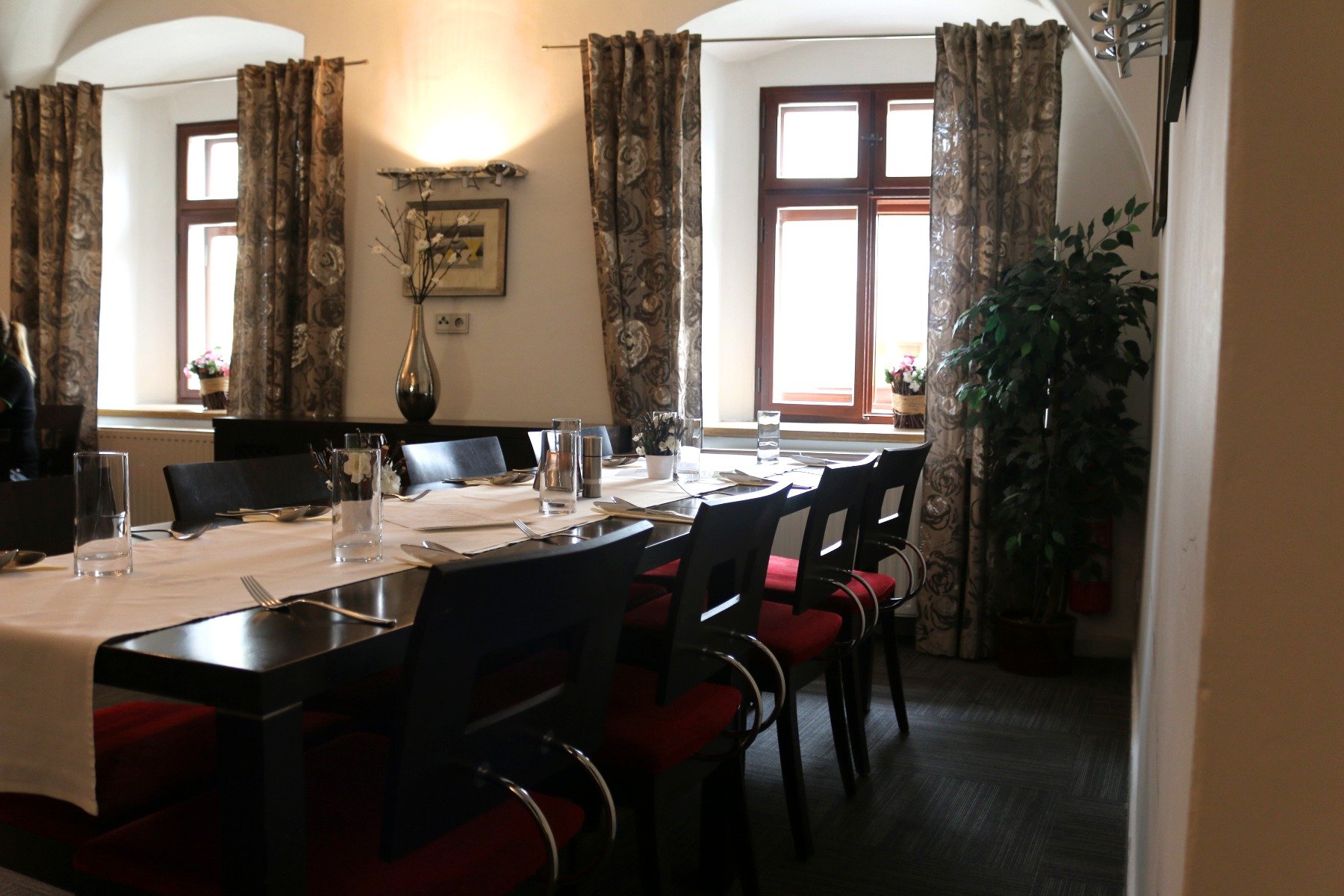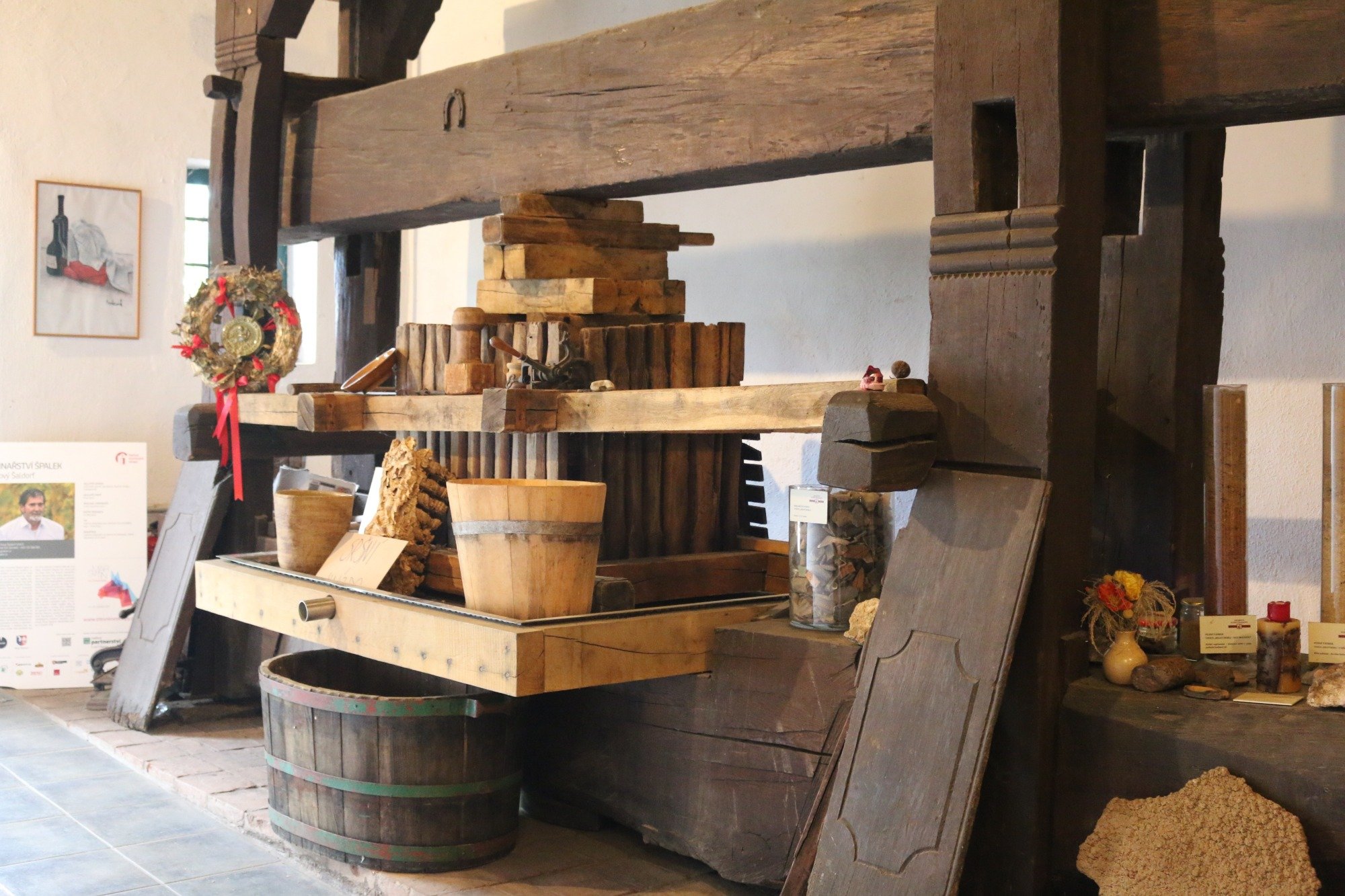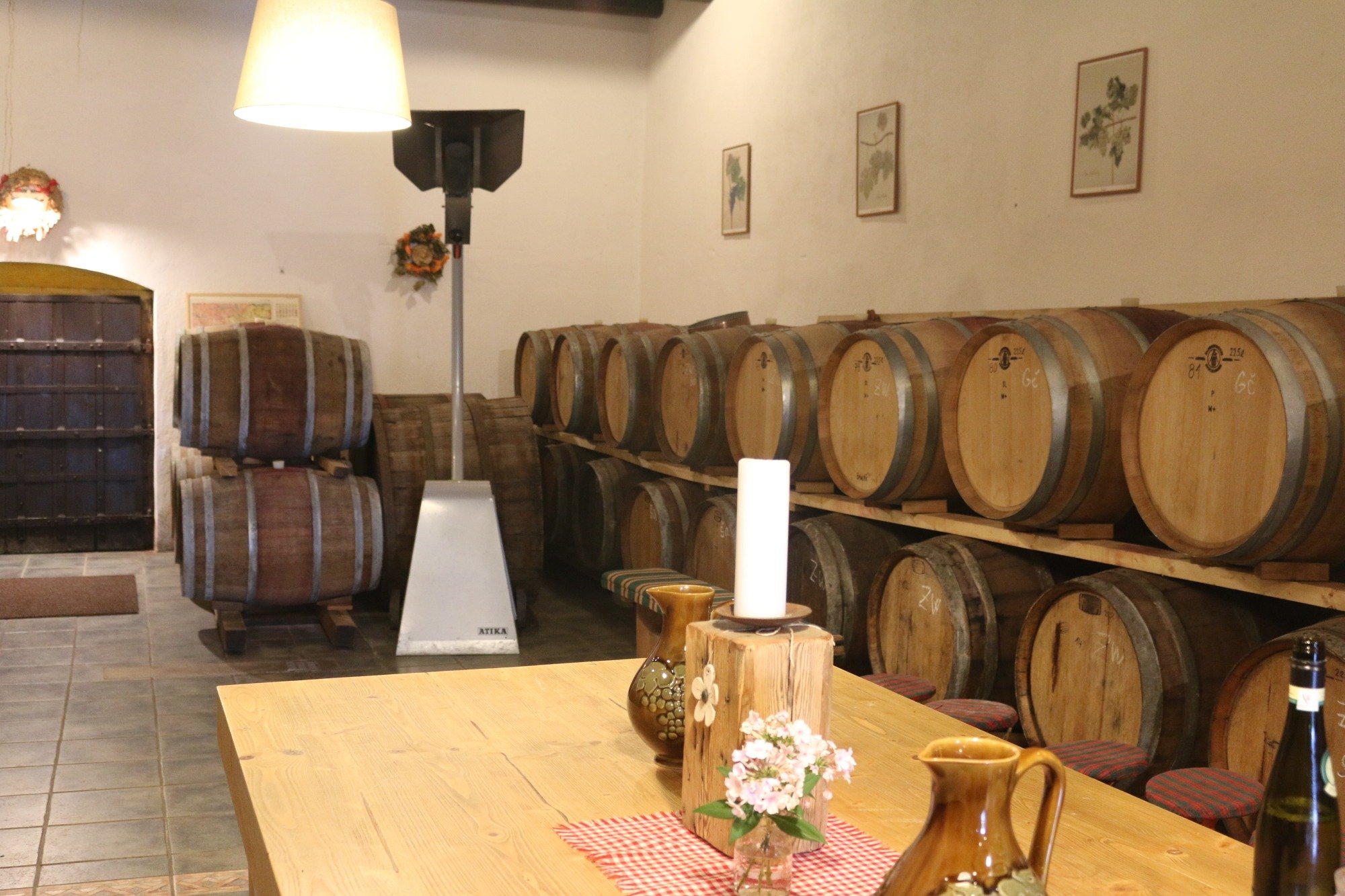Znojmo
Overlooking the Dyje river in the Lahofer tasting room in Znojmo, I thought to myself, I have landed in the heart of wine country. Rolling hills, terraced vineyards and ancient Roman buildings are reminiscent of the landscapes in Tuscany.
Once considered to be a stronghold in the Roman Empire, stone streets and ancient fortified walls line the city. Thousands of years of history are planted deep here in the vineyards, and innovative winemakers continue to push the envelope. As both a foreigner and a sommelier, I am truly in awe at the breadth of wine, the diverse microclimates, and the pioneering wineries representing this remarkably historic, wine-rich region.
Yet today, the city prides itself on this extensive history, steeped in Moravian customs. Winemakers are producing more bottles than ever before, aiming to simply keep up with the high demand within the country’s borders.
Nestled at the Czech/Austrian border, Znojmo is one of the oldest cities in Central Europe, tracing its roots back to the 8th century. Over the years, the city has survived centuries of change, and political and economic hardships.
After spending hours contemplating the lineups for my upcoming September wine classes, I knew I wanted to select a few wines from Znojmo. The region intrigued me. It is one of the four that comprise South Moravia, and offers a unique terroir, different to that of its neighbors. Thus far, the wines that I have tried have been exceptional, and I knew I had to check it out for myself. My primary goal in wine education is to gain first hand knowledge, directly from the wine community, to understand the history and sense of purpose that is reflected in their wine. This trip certainly exceeded my expectations.
One producer that was responsible for my initial interest was Špalek Vinařství, currently the only biodynamic winery in Znojmo. They are considered by many to be one of the top wineries in the country, utilizing both experimental and traditional techniques that enhance the terroir-specific quality in their wine. Curious to know more, I set up a tour and tasting appointment with the winery and organized my trip.
I am excited to share my experience and travel tips with you, to give you a glimpse into the sights, sounds and wines of Znojmo.
Getting There
As a foreigner, it can seem tricky to navigate the bus routes coming in and out of Brno city center. Believe me, I certainly had my hesitations before hopping aboard. After doing a bit of research on the IDOS app, I discovered the optimal method of transport is the Bus 108, accessible by Trams 2 and 5.
If traveling by tram to Ústředni Hřbitov, meaning Main Cemetery, the bus station is found just adjacent to the tram stop. The bus leaves practically every hour from Brno Ústředni Hřbitov to Znojmo, and is direct, convenient and inexpensive. The easiest outlet to purchase a bus ticket is at the Main Ticket Office at Hlavní Nádraží.
Expect to spend 49 CZK for a 6 Zone, 120 minute, one way ticket. Pro tip: If you’re planning a few trips to the region over an upcoming period of time, purchase a few in advance. They typically have a 3 week validity date, and an advance purchase helps to avoid the oftentimes hectic lines at Hlavní Nádraží.
Certainly, you can purchase a ticket from the bus driver once aboard, but since my Czech is subpar, I prefer to have a ticket on hand prior to travel. Validate it once you’re inside, and off you go! The bus does feature an updated, electronic itinerary, useful for indicating your whereabouts and expected times of arrival for each local stop.
If you have extra time to spare at the bus stop, take a stroll through the cemetery, making sure to pause a moment to visit Gregor Mendel’s gravesite. He is one of the founding fathers of genetics and has had a lasting impact on modern day science. The cemetery offers a serene, peaceful environment in the heart of the city, and is one of my favorite, secret spots in Brno.
Chance Encounters
Life is all about chance encounters. A few months ago, while attending the Wine Meritage event at the Planetarium, I was introduced to Petra Pokorná, a Znojmo native and Manager of vinotrh.cz, an e-shop featuring the most prestigious wines of Znojmo.
She has dedicated her life to promoting her hometown, in marketing, commerce and wine tourism. We chatted a bit at the event, and a few days later, met for a glass of wine in Brno. Petra described to me the few years she had spent in California, where she picked up her love of English and her forward thinking, progressive ideas for her company. She is dynamic, motivated and eager to increase tourism in Znojmo, and needless to say, we totally hit it off.
During my pre-planning stages, I emailed Petra to see if she would be free to meet me. Within hours, she quickly replied, graciously agreeing to show me around the city. As I had booked an appointment to meet with Marek Špalek in the latter part of the afternoon, Petra invited me to lunch and a walking tour of her city. I am grateful for her kindness and willingness to share her experiences and time with me. Never before have I felt so welcome than in South Moravia.
My day in Znojmo, Moravia’s Hidden Wine Destination
After scooping me up from the bus station, we drove over to Restaurace Veselá 13, located in the Lahofer Hotel, smack in the heart of Znojmo.
This stylish restaurant is open for hotel and non-hotel guests, offering both indoor and outdoor seating. A daily lunch menu and à la carte menu are available, showcasing a contemporary take on Czech cuisine. Restaurace Veselá 13 is the perfect starting point to a day packed with sightseeing and wine tasting.
Additionally, inside the hotel reception, is a gift shop featuring Lahofer wines and specialty jams and snacks. The complete Lahofer wine range is available on the Vinotrh E-Shop, offering everything from their crisp Sauvignon Blancs to their sweet Tramín Červený.
The Czech wine industry is evolving at a rapid pace, and thanks to individuals like Petra, Znojmo is leading the way in wine tourism. Currently under construction in one of the most desirable locations in the city, is the exclusive tasting room for Vinotrh.
Overlooking the St. Nicolas Church and Dyje river, the tasting room will offer an open-air concept, featuring panoramic views of the city. But this tasting room is not like any other in the country. It will highlight the incredible array of the wines of Znojmo, by facilitating the wine tasting experience for the consumer. Samples will be provided by a 120 bottle enomatic machine, the largest of its kind in the entire Czech Republic. With a projected completion date in mid September, this will be a unique tourist attraction, offering multi-tiered reception seating, garden access and an expansive view overlooking the Znojmo castle.
After a quick tour of the new tasting room facility, we continued on our walking tour of the city. Climbing the hill to the Znojmo castle, I was immediately overwhelmed by the breath taking, scenic views. Never before could I have imagined these magnificent vistas actually existed here, as this region is practically unknown to Americans like myself.
Meandering past the Rotunda of St. Catherine, an ancient Roman building dating back to the 12th Century, I admired the preservation of Roman history, and respect for the country’s heritage.
The Rotunda was declared a national cultural monument in 1962, and contains painted frescoes depicting the cycle of Christ’s youth and the Annunciation to the Blessed Virgin Mary. It served as a prayer chapel in ancient times, and today, offers limited daily tours, to prevent unnecessary damage to the interior.
As we enjoyed the scenery from the Lahofer tasting room on a cliff overlooking the river, we sipped a taste of the 2015 Lahofer Rajská, meaning Paradise. The grapes are harvested steps away, on the terraced plots adjacent to the tasting room. The Rajská wine was both complex and refreshing, perfect for a sunny afternoon.
Over the course of our discussions, Petra explained to me the details of the established Znojmo wine laws. Created in 2006, the VOC Znojmo was the first VOC in South Moravia. It comprises the designated wine laws of the region, detailing the specifics of permitted grape varietals and key production methods. This particular certification applies only to three grape varieties: Riesling, Sauvignon Blanc, and Grüner Veltliner. These white grape varieties reflect the unique microclimate of Znojmo’s terroir, specifically the region’s clay soils and cooler temperatures. Znojmo’s VOC serves as a guarantee of quality for the consumer, and ensures consistency in the regionally-specific aromas and flavors found in the wines. Otherwise known as Vína Originální Certifikace (Original Wine Certificate), the Znojmo VOC works similarly to the established AOC in France. From its creation over 13 years ago, there are presently 20 VOC Znojmo members.
We headed over to the current Vinotrh tasting room located near the main square, where we sampled a delightfully sweet Tramín Červený. This particular venue will be moved over to the new facilities in mid September, but it was wonderful to get to taste more of Lahofer’s offerings.
Wrapping up our walking tour, we headed over to Balance Coffee, a newly opened coffee shop in the city center. Balance Coffee Shop offers a diverse menu of both hot and cold brew coffees, vegan bakery snacks and natural wines of the region. A cafe like this could not have existed 10 years ago in South Moravia, but today, the country is breaking through their communist past. Entrepreneurs are embracing a more global perspective on dining, wine and marketing. It is this inspirational movement that is driving the city, and country, forward.
I decided to sample a white wine blend from Jakub Smrčka, a young winemaker and recent graduate of the Viticulture program at Mendel University. The wine, “White Balance,” is a blend of Grüner Veltliner and Müller Thurgau made exclusively for Balance Coffee, and offers fresh, mineral driven aromatics and a juicy, citrus-driven palate. After enjoying our last sips of wine and coffee, Petra graciously dropped me off for my appointment at Špalek winery.
It was fascinating to learn firsthand about those passionate individuals in the wine community, striving to put Znojmo on the wine map. It is a hidden gem in the eastern European wine world, and I believe it will quickly become a trendy tourist destination for wine lovers.
Špalek Vinařství
It was early spring when I first tasted the wines from Špalek’s family winery, located in Nový Šaldorf, just outside Znojmo’s city perimeter.
I was browsing through the labels at a local wine shop, when bingo, I found my bottle. From the sheer design of the label , the wine intrigued me. It was a Pinot Blanc Sur Lie, indicating its maturation on the lees. This admirable production method typically creates an added complexity to the end product. I brought this bottle home and was shocked at its exceptional quality.
Špalek’s wine was unique, complex, textured and aromatic. It offered a minerality that I had thus far not tasted in Moravian wine. I knew that this wine was something special, and I had to know more about it.
In order to better understand Špalek winery and the family’s history, it is important to start from the beginning. Prior to 1989, the Czech Republic was under Communist Control, much like the rest of the Eastern Bloc, and the Soviet Union controlled the amount of personal property and wine production in the region. Wine could be made only for the family and neighbors, with strict regulations on yields, production and vineyard ownership. Although the Špalek family owned vines prior to Communism, the Soviet state took them over, allocating only 0.1 hectares per family during their entire 50 year political reign.
Yet after the Velvet Revolution in 1989, 12 hectares of land were returned to the Špalek family and in 1997, vines were planted by Marek and his brother, Petr. Today, the Špalek family boasts over 10 different grape varietals, and produces over 80,000 bottles of wine each year. They are also the only organic and biodynamic winery in the Znojmo VOC.
Marek Špalek, of Špalek Vinařství
I had confirmed an appointment for the mid afternoon with Marek Špalek, the head of sales and marketing for the winery. He is the son of František Špalek, the family patriarch and original founder. The Špalek winery surprised me by its responsible approach to winemaking, respect for nature, and dedicated preservation of tradition. Additionally, the family is supportive and united, as each family member contributes in some way to their business.
Špalek’s sprawling vineyards are located on the gently sloping hills of Kraví Hora, translating to Cow Hill, offering some of the most highly desired vineyard sites in the region.
Featuring a gravity-fed production facility, high quality machinery and Austrian oak barrels, the winemaking process is carefully controlled from start to finish.
In addition to outstanding wines, I must add that my favorite part of the tour was their immense cellar, located 10-15 meters underground. Over thousands of years, sediment and sandstone deposits from ancient bodies of water that once covered the region, are now the home to the family’s wine cellar. There is no need for reinforcement by brick, as the natural curvatures and foundation manage to maintain the cellar’s integrity. The constant 11℃ temperature is ideal for barrel maturation and long term cellaring of archived bottles.
Entering back into the tasting room, Marek generously pulled samples of wines for us to taste, detailing the various techniques used to create their family’s wine collection. One remarkable feature that I noticed throughout the tasting was the consistency in the wine’s pronounced mineral expression. This earthy component can oftentimes be difficult to achieve, as it requires a deft hand and keen knowledge of the vines. It also reveals a glimpse into the passion of the winemaker, revealing a harmonious balance between wine and nature.
Although the overall lineup was quite impressive, two of my standouts included the 2017 VOC Sauvignon Blanc and the Edelspitz, a 50/50 blend of Gewurztraminer and Pinot Gris. The Sauvignon Blanc exploded with notes of minerality, freshly cut grass, spicy white pepper, tea and a powerful saline quality on the palate.
The Edelspitz wine was remarkable. The production method is quite intensive, and requires vast knowledge of fermentation and maturation. First, the grapes for this wine are crushed by foot in traditional lagares, and are then matured for 1 ½ years in 500L oak barrels. The end wine is unfiltered with minimal sulfite additions. It evoked a pronounced bouquet of orange blossom, stone fruit and minerality, while the palate had grippy tannins and mouth watering acidity. It was an absolute treat and a completely unexpected surprise.
Marek was gracious and generous in his time, offering me a glimpse into how his family produces high quality wine. They display an unparalleled bond with nature and the specific terroir of Kraví Hora, and by incorporating both traditional and modern techniques, produce exceptional wine. Their wines are available throughout Brno, both on e-shops and in stores.
Znojmo’s Wine Future
It is winemaking like this that excites me, that motivates me to keep researching and writing, discovering new regions and grape varietals. The wine community in Znojmo is inventive, creative and passionate about their craft. They are striving to break the mold of those before them, yet are keen to maintain a sense of tradition and history. I could not have been more surprised by the beauty of Znojmo, and look forward to my next journey to wine country.


